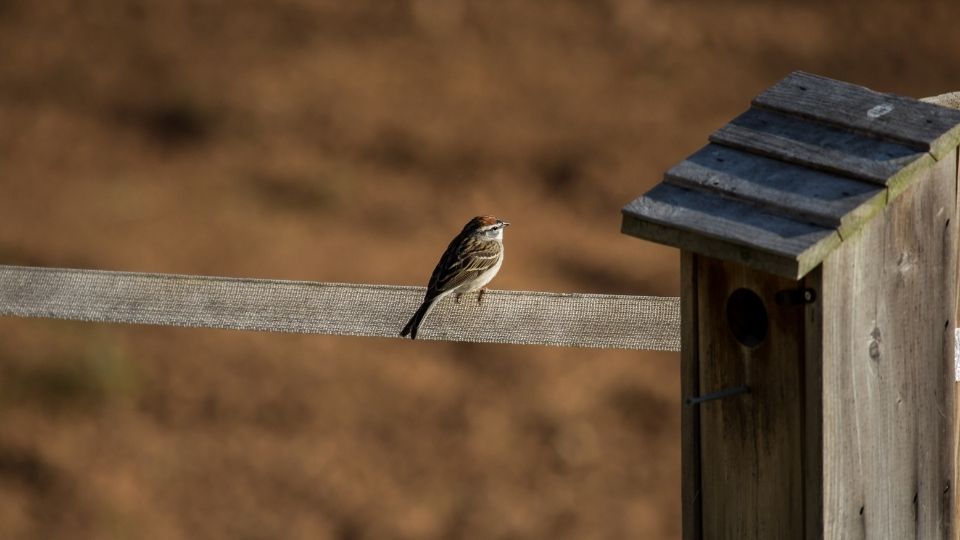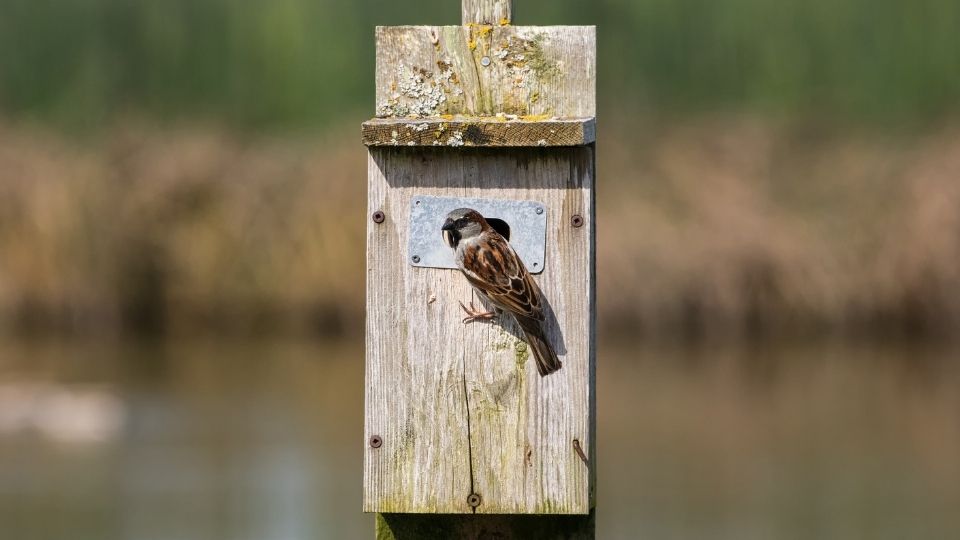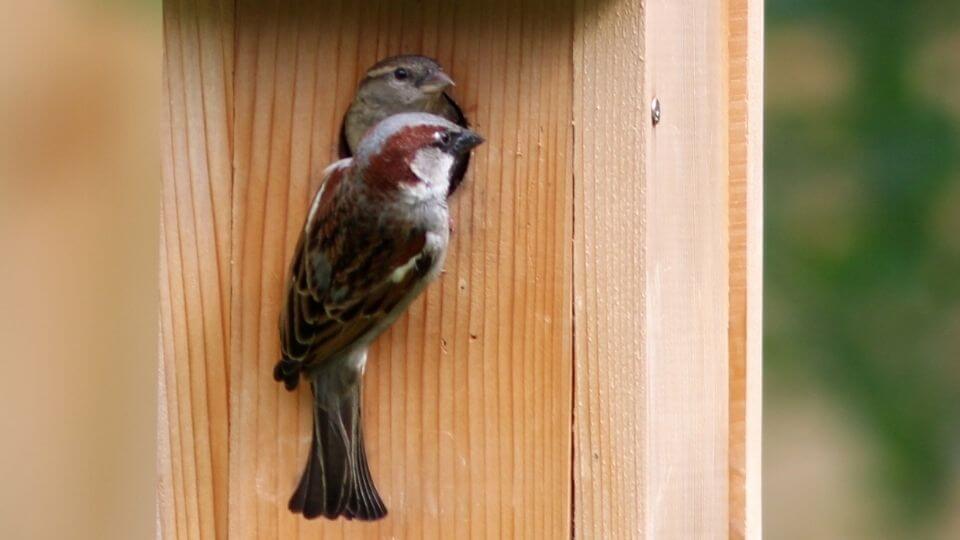Sparrows are secondary cavity-nesters meaning that they will take up residence in an abandoned cavity or nest. You can build a sparrow birdhouse with simple materials or you can purchase one for their use. Sparrows like birdhouses with small entrance holes and a lot of coverage.
There are quite a few species of sparrow in North America, but none is as common as the house sparrow. This non-native species favors urban areas near people. They are secondary cavity-nesting birds, much like the invasive starling.
Whether you enjoy house sparrows or find them to be a nuisance is a personal preference for every bird lover. They present problems for other backyard birds, but there are ways to help native species thrive where house sparrows are prevalent.
Regardless of if you love house sparrows or want to make room for other sparrows and songbirds to move in, building a sparrow birdhouse can help you achieve your goals.
House sparrows are opportunistic cavity nesters. They will build their nests in any crevice, eaves, or other building openings. This can damage your home and create a mess around your entryways.
One of the best ways to keep house sparrows from nesting in your house is to provide them with an alternate nesting site. An alternate nesting site is also an effective way to keep house sparrows from taking over potential nesting sites of other birds, like the song sparrow.
So, what is the best birdhouse for sparrows, and how do you build a birdhouse that will encourage house sparrows to nest in boxes instead of your eaves?
First, we’ll address some common questions about what type of birdhouses different sparrow species prefer; then, we will give you information on building your own sparrow birdhouse.

Do all sparrows like the same kind of birdhouses?
Even though house sparrows and native sparrow species look similar, they have completely different nesting habits. Song sparrows prefer nesting near the ground in small shrubs, trees, and trailing blackberry bushes, while house sparrows prefer cavities in building such as eaves and any other opening in a building.
The fox sparrow is another native species that nest in shrubs and bushes. Another sparrow, the dark-eyed junco, prefers nesting under root balls or in tall grass.
Since these species are mainly ground nesters, they will likely not use a birdhouse. But you can still create a backyard habitat that will attract many different types of wild birds.
You can entice these native sparrow species to your backyard by planting an area of your yard with dense shrubbery, ornamental grasses, and other dense landscape. Well-planted greenery provides ample places to nest and attracts bugs–the sparrow’s favorite food!
While a house sparrow tends to be lumped into the sparrow group, they are not related to any native North American sparrows. Because of this, their nesting habits are entirely different than many of the native species of sparrows.

What is the best kind of birdhouse for a house sparrow?
House sparrows like four-sided birdhouses with a circular entrance hole at least 1 ¼ inches in diameter. These tiny birds prefer birdhouses that are hung close to a building and at least 15 feet off the ground.
Aside from their preference for nesting and roosting near buildings, house sparrows are pretty easy to please when it comes to birdhouses. A floor space of at least 4 inches on each side is plenty of room for a house sparrow.
House sparrows like a lot of cover, so make sure the entrance hole is at least 6 inches from the floor. This will provide plenty of protection from the elements and keep nestlings out of sight of potential predators.
Once you’ve chosen the perfect birdhouse, you can fill it with dry grasses and other nesting material, but you don’t have to. House sparrows are readily attracted to any cavities where they can roost or nest.
Make sure to hang your birdhouses at least 10 feet from bird feeders and baths. Clean up spilled bird seed daily so you don’t attract predators who may want to check out your new birdhouses.
Once your sparrow birdhouse is hung, it won’t be long before a sparrow moves in.

What materials do I need for a DIY sparrow birdhouse?
If you prefer a handcrafted birdhouse, choose at least 3/4” thick wood to provide enough insulation. A 1″ x 6″ board that is 4 feet long is enough to make one house sparrow birdhouse.
You can build several types of birdhouses for sparrows, but this construction is one of the most simple and common types. It is taller than it is wide, so it does not look like a typical birdhouse.
Materials to build the sparrow birdhouse
Use natural wood from sources that are not treated with chemicals. Redwood, red cedar, and pine are all excellent woods for your birdhouse.
Natural wood can be purchased at your local hardware or home building store.
Prepare the birdhouse building materials
Once you have your plank, you will need to cut it into six pieces:
- One 5” piece (base)
- One 7” piece (front)
- One 8” piece (roof)
- One 12” piece (back)
Cut two pieces that are 7” high on one side and 8” high on the other. You can do this by making a diagonal cut in the center of a 15” length of the board. Measure from the end to 7” on one side, then measure from the same end to 8” on the other side. Connect the dots across the board to create your diagonal line.
Drill an entrance hole near the top of your front piece, leaving about one inch from the edge of the board. The bird’s entrance hole should be at least 1 and ¼ inches and circular.
You can also drill small holes in the base to allow moisture to drain and drill holes in the back for mounting.
Assembling the sparrow birdhouse
Use nails or screws to assemble the birdhouse, then assemble the birdhouse in the following order:
- Attach the base to the backboard first
- Attach the walls to the back and base with the higher sides to the back so the roof will slope down over the entrance hole
- Attach the front to the walls and base, making sure the entrance hole is near the top, not the base
- Attach the roof flush with the back. You can use a hinge for easy clean-up or attach the roof with nails
- Sealing the seams with wood glue will make your birdhouse less drafty but is not necessary
- Hang your birdhouse at least 15 feet high. You can hang it on a tree near a building or use a pole

Should I provide a separate sparrow nest box?
House sparrows will happily nest in a birdhouse or a nesting box, so you don’t need to hang a separate box. As long as the birdhouse is four-sided and the entrance hole is at least 1 ¼ inches in diameter, house sparrows will use it as a nest house.
House sparrows are secondary cavity nesters. This means they cannot create their cavity as a woodpecker does.
Being secondary cavity nesters also makes house sparrows opportunistic when it comes to choosing their nesting sites. They’re not picky and will raise their baby birds in most wooden birdhouses.
Is providing multiple birdhouses for house sparrows beneficial?
Offering multiple birdhouses for house sparrows gives them plenty of places to nest and re-nest. Renesting between broods helps prevent parasitic infections and means sparrows can lay more eggs quickly.
Sparrows will also nest and roost together, which means you can hang multiple birdhouses and nesting boxes in one area or even use a communal nest box.
Sparrows are known to overtake nesting sites of other songbirds, so the more desirable options you can provide these brave little birds, the better it is for all your feathered friends.
Building a house sparrow birdhouse is a fun and easy DIY project that can help these feisty little birds find places to nest outside your eaves and light fixtures. Plus, providing house sparrows with ample birdhouses to nest in can prevent competition between house sparrows and native songbirds.
Whatever your reason for building a birdhouse for your house sparrow, these tips and tricks will help you get one up quickly so you can get back to bird watching!

